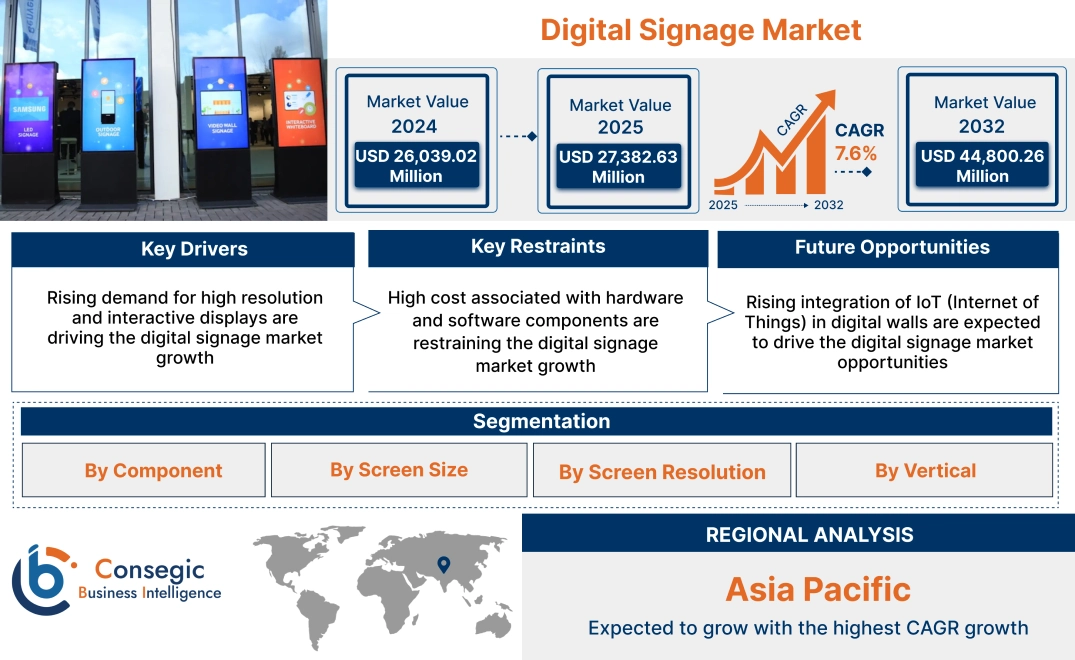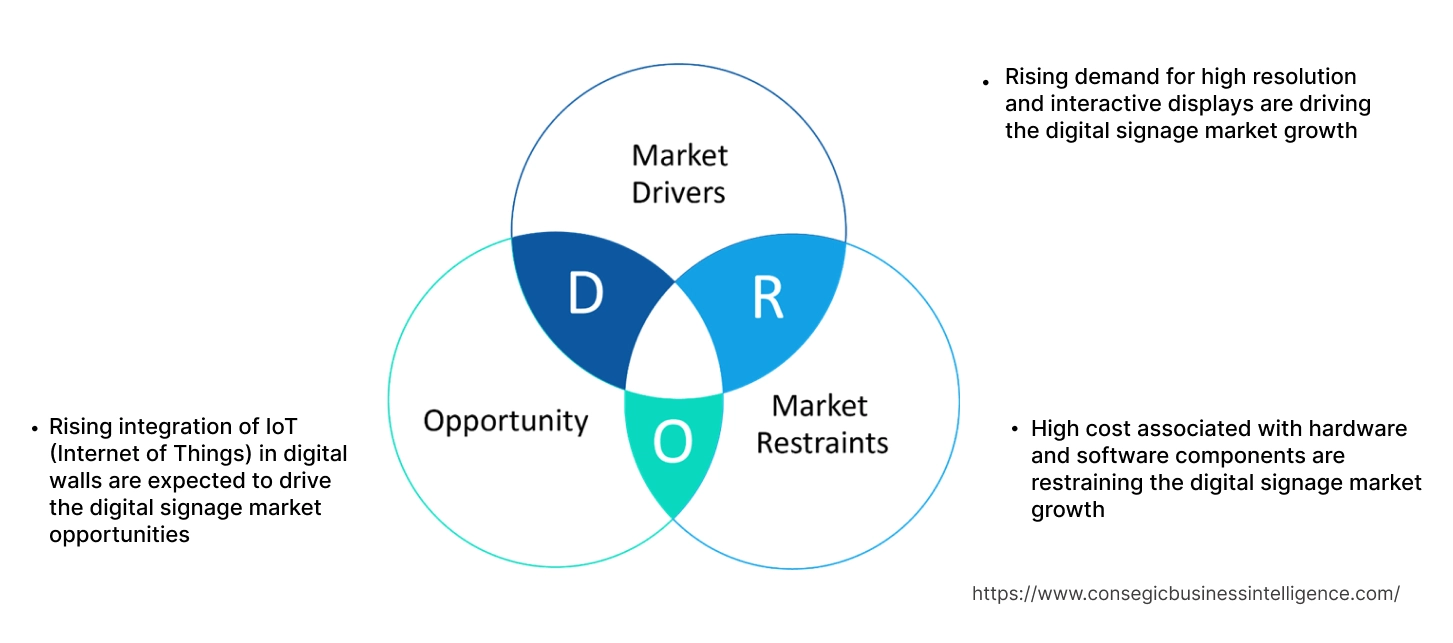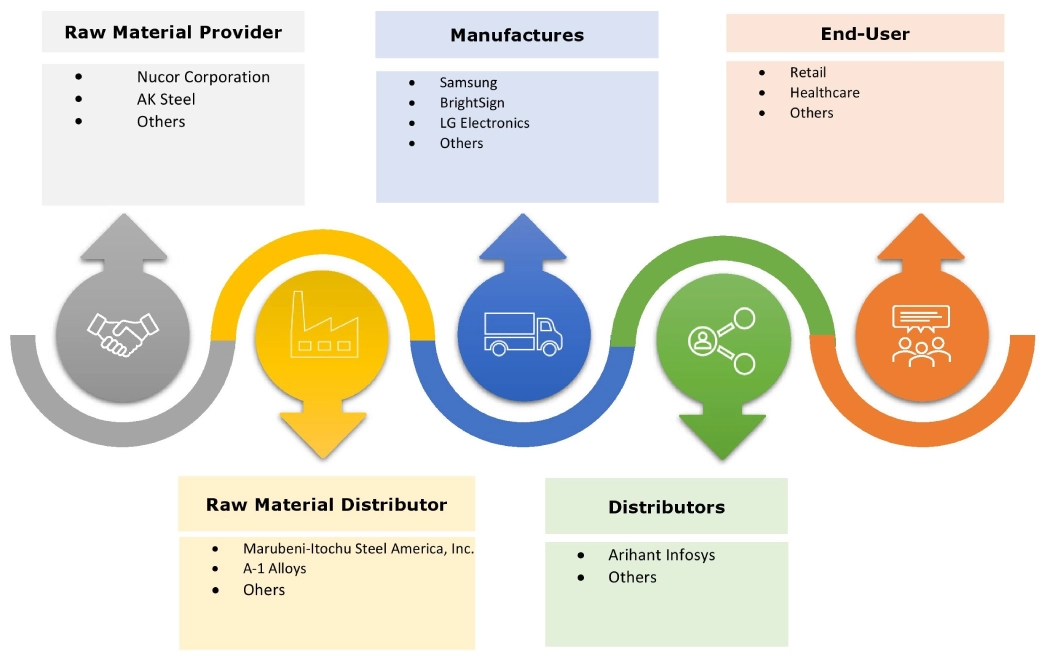- Summary
- Table Of Content
- Methodology
Digital Signage Market Size:
Digital Signage Market size is estimated to reach over USD 44,800.26 Million by 2032 from a value of USD 26,039.02 Million in 2024 and is projected to grow by USD 27,382.63 Million in 2025, growing at a CAGR of 7.6% from 2025 to 2032.
Digital Signage Market Scope & Overview:
Digital signage (DS) system is a modern signage system which displays information such as customized content, live TV and media playlists to one or more displays. Further, digital signage systems are used for external and internal communication for enabling advertisements to a specific audience at a specific time and place, allowing businesses to display targeted information. Moreover, it provides a central navigation to the system by CMS (content management software) for updating content fast and easily. Additionally, the support of multimedia content makes the system a suitable tool for communicating a broad variety of stories and advertisements to reach target groups.
Key Drivers:
Rising demand for high resolution and interactive displays are driving the digital signage market growth
There is an increasing utilization of high resolution and interactive displays in retail, healthcare, hospitality, corporate offices, airports, subways, and others. Further, it offers various advantages to the businesses by reducing printing costs, automating promotions, providing information in transit centers, and others. Moreover, interactive display in restaurants and cafes enhance customer experience by enabling quick access to information. Additionally, increased quality of content presentation in 4K and 8K resolution attracts attention to the advertisement or promotions.
- For instance, in January 2025, LG Electronics USA collaborated with BrightSign LLC for ultra-high definition (UHD) digital signage displays, running BrightSignOS on LG’s multi-core processor with various BrightSign partner content management system (CMS) solutions for various industries including retail, transportation, healthcare, hospitality, corporate, museums, and education.
Thus, as per the analysis, the rising utilization of high resolution and interactive displays are further driving the market.
Key Restraints:
High cost associated with hardware and software components are restraining the digital signage market growth
Digital signage systems face significant challenges due to high cost associated with hardware and software components. Moreover, these systems include hardware such as digital displays (screens), mounting stands, and media players, which increases the overall cost of acquisition and implementation. Further, additional costs such as maintenance and content are important for enabling smooth operation.
For instance, LG offers signage displays in its product offerings. The company's signage product cost ranges from USD 1,000 to USD 15,000, depending on the quality of resolution and display size. Thus, as per the analysis, the high costs associated with signage hardware and software components are restraining the digital signage market expansion.
Future Opportunities :
Rising integration of IoT (Internet of Things) in digital walls are expected to drive the digital signage market opportunities
The increasing integration of IoT (Internet of Things) in digital systems is transforming the wall display technology by enhancing business efficiency, security, and others. Further, digital walls are integrated with databases, sensors, and cameras to change displays dynamically in locations such as energy grids, factory floors, transportation systems, and healthcare facilities. Additionally, IoT enables data analysis and management capabilities to automatically tailor the content for real time operations.
- For instance, in July 2024, Elo launched its new 04-series touchscreen digital signage, which includes 32-inch 3204L, 43-inch 4304L, 50-inch 4K 5054L, and 55-inch 4K 5554L for businesses along with the integration of a chip for supporting IoT.
Thus, as per the digital signage market analysis, rising utilization of IoT in display systems are projected to drive the global digital signage market opportunities during the forecast period.
Digital Signage Market Segmental Analysis :
By Component:
Based on the component, the market is segmented into display, media player, software, and others.
Trends in the Component:
- There is an increasing trend towards utilization of multimedia player for managing video and other sources of content.
- Increasing utilization of touch screen displays in various industries for handling variety of media inputs.
Display segment accounted for the largest revenue of 45.86% in the total digital signage market share in 2024.
- Signage displays are built for long hours of use and they include additional hardware such as cooling fans, electronics and heat dissipation plates which enables them to operate in commercial environments for longer duration.
- Further, these displays are suitable for businesses which requires longer periods of time such as 16 to 24 hours a day.
- For instance, in July 2024, BenQ India launched BenQ Board RE04 Series, an interactive flat panel integrated with Google Mobile Services (GMS) for revolutionising collaborative spaces in corporate and education environments.
- Thus, the rising advancements in interactive display segment are driving the digital signage market trends.
Software segment is anticipated to register a substantial CAGR growth during the forecast period.
- Software includes CMS (content management system) which helps user manage, create, and publish content on the displays
- Further, CMS offers various benefits including real-time updates, scalability, content scheduling, security, automatic updates, and others.
- For instance, in July 2023, GDS GmbH launched XR/engineering content management system with various features including callout editor, which enables writers to add information to graphic images on multiple levels.
- Thus, the rising advancements in content management system are expected to drive the digital signage market trends during the forecast period.
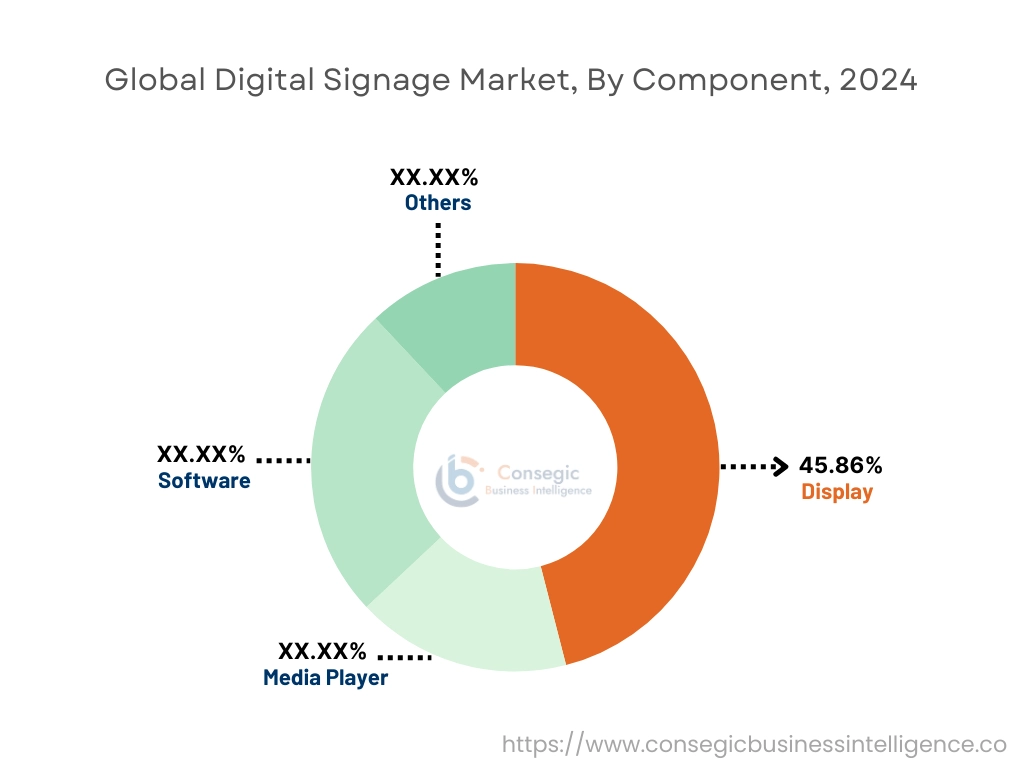
By Screen Size:
Based on the screen size, the market is segmented into less than 30 inches, 30-42 inches, and more than 42 inches.
Trends in the Screen Size:
- There is an increasing trend towards utilization of 30-42 inch displays in fast food shops for displaying menu and others.
- Rising adoption of large displays over 42 inches in educational institutes due to large viewing angle, making it suitable for large group of students.
30-42 inches accounted for the largest revenue share in the total digital signage market share in 2024, and it is anticipated to register fastest CAGR growth during the forecast period.
- There is a rising utilization of 30-42 inch displays in retail stores, restaurants, and hospitality venues, where compact displays enhance customer engagement and advertising effectiveness.
- Moreover, these displays offers various benefits including high resolutions, making it ideal for indoor applications such as menu boards and advertisement boards among others.
- For instance, Samsung offers intelligent displays of 40 inches in its product offerings. It offers various features including premium picture quality, high brightness, and improved visibility among others.
- Thus, the rising adoption of 30-42 inches smart displays in retail, restaurants, and others are further driving the market.
By Screen Resolution:
Based on the screen resolution, the market is segmented into 1080p, 4K, and others.
Trends in the Screen Resolution:
- There is an increasing utilization of 1080p full HD displays in retail outlets for advertising products and surfaces.
- Increasing utilization of 4K-enabled display solutions in luxury stores for improved branding of luxury goods.
1080p segment accounted for the largest revenue in the total market in 2024.
- The 1080p segment is the ideal resolution due to its optimal balance of affordability and high definition visual clarity.
- Moreover, it offers various benefits including reduced costs to businesses for delivering sharp and engaging content while maintaining lower operational costs.
- For instance, Limeberry offers 43 inch indoor DS with full HD resolution LED display in its product offerings. It offers various features such as dual Wi-Fi 4.2 & 5G, 2 USB drives, 2 HDMI (ARC), LAN, coax devices, and others.
- Thus, the rising adoption of full-HD intelligent displays in restaurants, cafes, and others are further driving the market.
4K segment is anticipated to register a significant CAGR growth during the forecast period.
- 4K displays create appealing product promotions on intelligent displays for both retail market and video streaming market, enabling deployments to really stand out from the crowd.
- Moreover, the increased quality of content presentation offered by 4K-enabled display solutions is suitable for luxury brands as their investment in branding is paramount for gaining maximum attraction.
- For instance, in 2024, AG Neovo launched NSD-Series All-in-one 4K digital displays, an ultra-high visual resolution quality with 8.3 million pixels and ultra-high audio for improving user’s experience.
- Thus, the rising developments related to screen resolutions are further driving the digital signage market size.
By Vertical:
Based on the vertical, the market is segmented into retail, entertainment, transportation, hospitality, healthcare, banking, and others.
Trends in the Vertical:
- There is an increasing utilization of intelligent displays in retail stores for advertising products and offers.
- Rising adoption of digital screens on transportation terminals and vehicles, including buses, cars, planes, and trains.
Retail segment accounted for the largest revenue share in the total market in 2024.
- In retail stores, intelligent displays are adopted for delivering real life and eye catching picture quality for improving in store experience.
- Further, in retail sector, these intelligent displays have the potential to offer personalised experiences for consumers, offering tailored deals and promotions, through a content management system.
- For instance, in September 2021, Sony launched B2B displays for retail applications, which is equipped with different screen sizes, 24/7 operation, mirroring functionality, IP control, and pro mode for customized settings.
- Thus, the rising advancements in displays for retail applications including advertising and promotion are further driving the digital signage market size.
Education segment is anticipated to register a substantial CAGR growth during the forecast period.
- Intelligent displays are increasingly adopted by universities and schools for educational purposes such as learning environment and others.
- Further, it offers various benefits including video lectures, 3D animations, coordinated academic activities, and others.
- For instance, in January 2025, LG introduced LG SCHOOLS program for K-12 educational institutions, offering commercial display tech for schools to learn, deploy, and test.
- Thus, the rising adoption of intelligent displays in educational institutes is projected to boost the market during the forecast period.
Regional Analysis:
The regions covered are North America, Europe, Asia Pacific, the Middle East and Africa, and Latin America.
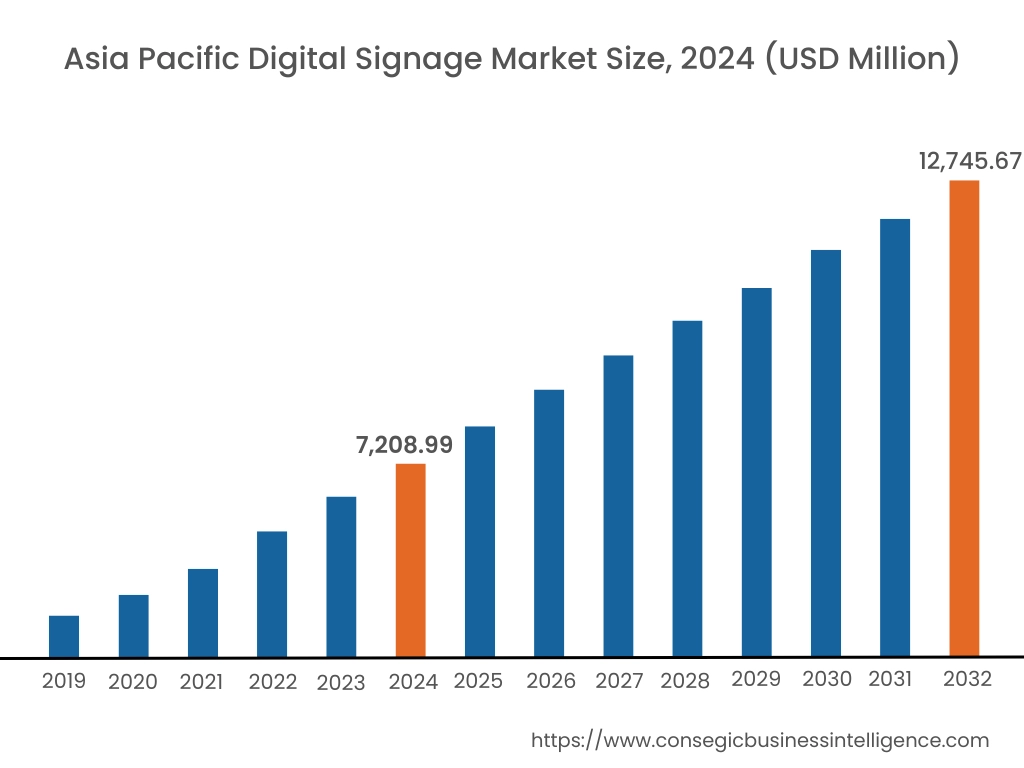
Asia Pacific region is estimated to reach over USD 12,745.67 Million by 2032 from a value of USD 7,208.99 Million in 2024 and is projected to grow by USD 7,598.42 Million in 2025. Out of this, China accounted for the maximum revenue share of 33.2%. As per the digital signage market analysis, there is an increasing adoption of display systems, particularly in countries such as China, India, and Japan, in retail, entertainment, hospitality, and other sectors for advertising and promoting purposes. The rapid development and growing investments in entertainment and hospitality sector are accelerating the digital signage market expansion.
- For instance, in November 2024, Accor launched 27 hotels across globe including Asia. This is further driving the adoption of intelligent display systems thereby, propelling the market in the Asia-Pacific region.
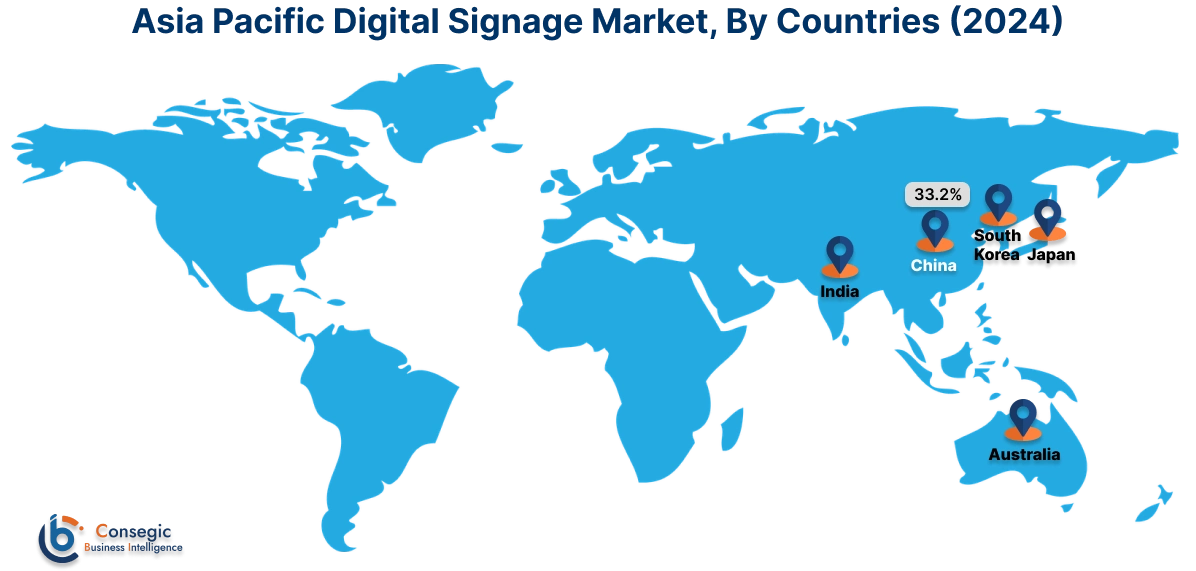
North America was valued at USD 8,989.08 Million in 2024. Moreover, it is projected to grow by USD 9,453.11 Million in 2025 and reach over USD 15,469.53 Million by 2032.
In North America, the growth of digital signage industry is driven by the rising demand for reliable high-definition display systems for advertising, increasing sales, and other related applications. Rising adoption of intelligent displays in corporate, healthcare, banking, and other industries are also driving the market. Further, increasing investments in healthcare, hospitality, and transportation sector are contributing to the adoption of digital signage market demand.
- For instance, in October 2021, Athens Group partnered with MSD Partners for developing a 216 room Four Seasons Resort at Florida’s Gulf Coast. This is further driving the adoption of display systems in reception and other relevant spaces of the resort, which in turn is driving the market in North America.
The regional analysis depicts that the rising investments in transportation industry and increasing adoption of display solutions in airports and transport stations for advertising promotions and showcasing information are driving the digital signage market demand in Europe. Further, as per the market analysis, the primary factor driving the market in the Middle East and African region includes increasing investment in hospitality sector. The rising demand for modern display systems in corporate offices, banks, and others are driving the market demand in the Latin America region.
Top Key Players and Market Share Insights:
The digital signage market is highly competitive with major players providing products to the national and international markets. Key players are adopting several strategies in research and development (R&D), product innovation, and end-user launches to hold a strong position in the global digital signage market. Key players in the digital signage industry include -
- Samsung (South Korea)
- BrightSign (US)
- Omnivex Corporation (US)
- Daktronics (US)
- Panasonic Corporation (Japan)
- LG Electronics (South Korea)
- Cisco (US)
- Microsoft Corporation (US)
- Intel Corporation (US)
- KeyWest Technology, Inc. (US)
- NEC Display Solutions (Japan)
Recent Industry Developments :
Product Launch:
- In January 2024, Samsung launched VXT (Visual eXperience Transformation) platform, a cloud-native content management solution for B2B displays including LED and LCD signage.
- In July 2024, Elo launched revolutionary 04-series touchscreen DS which includes 43-inch 4304L, 32-inch 3204L, 50-inch 4K 5054L, and 55-inch 4K 5554L for professional environments.
Digital Signage Market Report Insights :
| Report Attributes | Report Details |
| Study Timeline | 2019-2032 |
| Market Size in 2032 | USD 44,800.26 Million |
| CAGR (2025-2032) | 7.6% |
| By Component |
|
| By Screen Size |
|
| By Screen Resolution |
|
| By Vertical |
|
| By Region |
|
| Key Players |
|
| North America | U.S. Canada Mexico |
| Europe | U.K. Germany France Spain Italy Russia Benelux Rest of Europe |
| APAC | China South Korea Japan India Australia ASEAN Rest of Asia-Pacific |
| Middle East and Africa | GCC Turkey South Africa Rest of MEA |
| LATAM | Brazil Argentina Chile Rest of LATAM |
| Report Coverage |
|
Key Questions Answered in the Report
How big is the digital signage market? +
The digital signage market was valued at USD 26,039.02 Million in 2024 and is projected to grow to USD 44,800.26 Million by 2032.
Which is the fastest-growing region in the digital signage market? +
Asia-Pacific is the region experiencing the most rapid growth in the digital signage market.
What specific segmentation details are covered in the digital signage report? +
The digital signage report includes specific segmentation details for component, screen size, screen resolution, vertical, and region.
Who are the major players in the digital signage market? +
The key participants in the digital signage market are Samsung (South Korea), BrightSign (US), LG Electronics (South Korea), Cisco (US), Microsoft Corporation (US), Intel Corporation (US), KeyWest Technology, Inc. (US), NEC Display Solutions (Japan), Omnivex Corporation (US), Daktronics (US) , and Panasonic Corporation (Japan).
